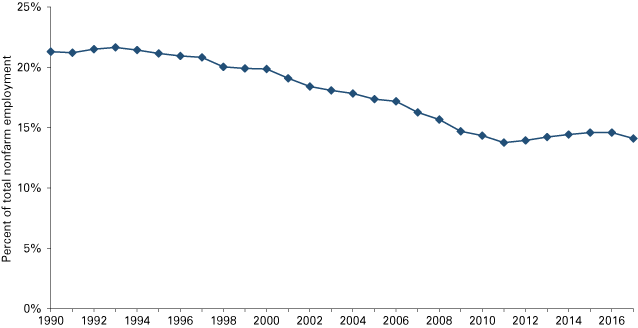Evansville forecast 2018

Professor of Economics and Dean of Business, Romain College of Business, University of Southern Indiana
The advanced-industry sector, which consists of advanced manufacturing, energy and high-tech services, is characterized by a relatively high concentration of science, technology, engineering and mathematics (STEM) workers and a relatively high level of research and development expenditures.
A report from the Brookings Metropolitan Policy Program, “America’s advanced industries: New trends,” highlights the role of the advanced-industry sector as a source of economic growth and productivity-driving innovations.1 In comparison to national averages for the shares of total employment and output, the Evansville metro area is well positioned to benefit from strategies aimed at enhancing its advanced-industry sector. While the advanced-industry sector accounts for 8.7 percent of workers and 17.2 percent of the output of the U.S. economy, the comparable figures for the Evansville metropolitan statistical area are 8.4 percent and 24.2 percent, respectively.
Construction activity, including the medical campus in downtown Evansville, a land-based casino and renovations at the Evansville Regional Airport, served as a timely buffer to the drag on output and employment resulting from the closure of Alcoa’s smelting plant in 2016. The boost in economic activity linked to investments in 2017 will continue in 2018 as projects related to the Southwest Indiana Regional Cities Initiative continue to be implemented and construction begins on a major nitrogen fertilizer production plant in the Evansville metro area.
During 2017, relatively strong growth in the construction, professional and business services, and health care sectors combined with increases in personal income and announcements of future fixed investments to provide the basis for projecting increased employment, output and income in 2018.
Once all data are released for 2017, nominal personal income is estimated to have increased by 3.4 percent and real gross metro product is estimated to have increased by 1.7 percent. In 2018, Evansville metro area output is forecasted to increase by 2.0 percent, the number of jobs is projected to increase by 1,500, nominal personal income growth is forecasted to increase by 3.7 percent, while the unemployment rate is projected to be 3.4 percent.
The unemployment rate in the Evansville metro fell from 4.5 percent in January 2017, to 3.3 percent in September 2017. There was also a decline in the national unemployment rate from 5.1 percent to 4.1 percent over the same time period. Job gains occurred primarily in professional and business services, construction, and health care. Meanwhile, sectors experiencing jobs losses included retail trade, as well as transportation, warehousing and utilities.
Between 2016 and 2017, homeowners experienced an increase in existing home prices from an average of $149,791 to $151,965, while housing starts decreased slightly from 921 to 918.
The manufacturing sector continues to be an important base to metro-area household incomes and consumer spending activity—even as the economy exhibits a long-term pattern of diversification away from manufacturing-industry dependence (see Figure 1).
Figure 1: Evansville metro manufacturing employment as a percent of total nonfarm employment

Note: 2017 data are for September.
Source: STATS Indiana, using U.S. Bureau of Labor Statistics and Indiana Department of Workforce Development data
As Table 1 shows, the manufacturing sector accounts for 14.1 percent of employment in the Evansville metro.
Table 1: Manufacturing's percent of total employment, September 2017
| Evansville metro | Indiana | U.S. | |
|---|---|---|---|
| Manufacturing | 14.1% | 16.8% | 8.5% |
| Durables | 38.4% | 72.4% | 62.3% |
| Nondurables | 61.6% | 27.6% | 37.7% |
Source: STATS Indiana, using U.S. Bureau of Labor Statistics and Indiana Department of Workforce Development data
But as one of the most manufacturing-dependent metro areas in the nation, the Evansville economy was noticeably impacted by the Great Recession. Since 2007, Evansville’s manufacturing workforce has fallen by 10.2 percent or about 2,600 workers, compared to the 3.2 percent reduction in Indiana’s manufacturing workforce over the same period.
In 2017, manufacturing earnings continue to be a significant driver of economic activity, accounting for about 21 percent of total earnings in the Evansville economy.
Outlook for 2018
Given the proportion of output that is sold outside of the metro area, the strength of the recovery in the Evansville area is linked to the strength of the broader economy. As employment and demand for locally produced goods continue to surpass pre-recession levels, disposable income and output growth are expected to increase in 2018.
A widening gap between the Evansville economy and the U.S. economy with regard to income growth over the past three decades highlights the importance of achieving higher rates of output and employment growth. Future strategies aimed at enhancing the role of the advanced-industry sector merit serious consideration.
Notes
- Mark Muro, Siddharth Kulkarni and David Hart, “America’s Advanced Industries: New Trends,” Brookings Institution, August 4, 2016, www.brookings.edu/research/americas-advanced-industries-new-trends/.



